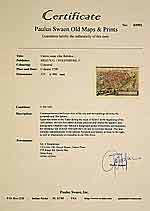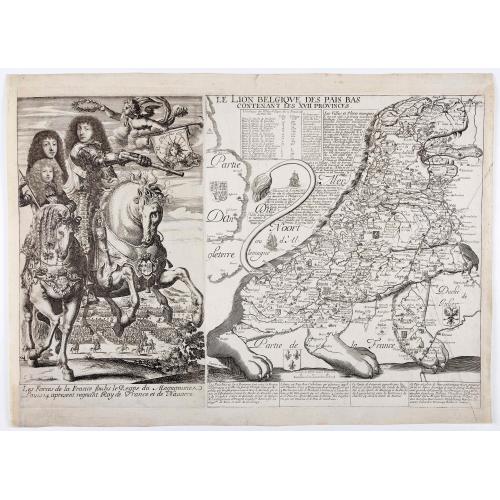Lot #: 45859
Le Lion Belgique des Pais Bas contenant les XVII Provinces. |
||||||||||||||||||||
|
||||||||||||||||||||
|
|
||||||||||||||||||||
|
Selling price: $20000
Sold in 2020 Join our News Letter to get informed when a similar item comes available. Do you have an example you would like to sell? |
Views: 290
|
|||||||||||||||||||
Description
The rare third state, of six, ofthis scarce Leo Belgicus map, of which Van der Heijden only lists 2 other examples. With the publisher's name "Lagnet" in lower left corner of the Leo map.
At the bottom the coat of arms of France; to the right those of the German Empire, in the middle those of England, Scotland and Ireland.
The map of the lion has been printed on one sheet, with in this third state, along the left side the equestrian figures of Louis XIV, his brother and his son.
The text underneath emphasizes the military ambitions of Louis XIV. Since in this text the Peace of Aix-la-Chapelle of May 1668 is mentioned - the first break in the so called Devolution War of France against the Spanish Netherlands - the map must have been issued after this date, though before 1672, the year in which the fourth state was published.
The sixth state was issued by another publisher, Gerard Jollain. He erased the name of his predecessor Lagnet.
Among the greatest decorative works of early cartography is a series of arresting maps showing The Netherlands and Belgium in the shape of a lion. The various versions of these so-called Leo Belgicus maps are all rare, only a few examples surviving and in some cases only a solitary specimen has been located.
The use of the shape of a lion in the depiction of the two countries arose in part from the fact that their actual shape is vaguely leonine. This commanding image was an apt symbol for a nation on the verge of unprecedented wealth and power.
Secondly, the lion had long figured in the national iconography of the area: most of the coats-of-arms of the 17 provinces of the countries feature a lion.
Also, the map was a statement of unity, since at the time the 17 provinces comprised a single nation, although under the yoke of Spanish domination.
A very limited number of examples were published outside and this Leo Belgicus is the most famous and most decorative French edition.
The engraver of the map was Valentin Le Febure (1642-1700).
The Leo Belgicus is modeled after the original engraving by Franz Hogenberg / Aitzinger.
Reference: Van der Heijden, Leo Belgicus 21.3 (Recording only 2 examples of this 3rd state) Tooley, N°.44, plate XIX.
At the bottom the coat of arms of France; to the right those of the German Empire, in the middle those of England, Scotland and Ireland.
The map of the lion has been printed on one sheet, with in this third state, along the left side the equestrian figures of Louis XIV, his brother and his son.
The text underneath emphasizes the military ambitions of Louis XIV. Since in this text the Peace of Aix-la-Chapelle of May 1668 is mentioned - the first break in the so called Devolution War of France against the Spanish Netherlands - the map must have been issued after this date, though before 1672, the year in which the fourth state was published.
The sixth state was issued by another publisher, Gerard Jollain. He erased the name of his predecessor Lagnet.
Among the greatest decorative works of early cartography is a series of arresting maps showing The Netherlands and Belgium in the shape of a lion. The various versions of these so-called Leo Belgicus maps are all rare, only a few examples surviving and in some cases only a solitary specimen has been located.
The use of the shape of a lion in the depiction of the two countries arose in part from the fact that their actual shape is vaguely leonine. This commanding image was an apt symbol for a nation on the verge of unprecedented wealth and power.
Secondly, the lion had long figured in the national iconography of the area: most of the coats-of-arms of the 17 provinces of the countries feature a lion.
Also, the map was a statement of unity, since at the time the 17 provinces comprised a single nation, although under the yoke of Spanish domination.
A very limited number of examples were published outside and this Leo Belgicus is the most famous and most decorative French edition.
The engraver of the map was Valentin Le Febure (1642-1700).
The Leo Belgicus is modeled after the original engraving by Franz Hogenberg / Aitzinger.
Reference: Van der Heijden, Leo Belgicus 21.3 (Recording only 2 examples of this 3rd state) Tooley, N°.44, plate XIX.
FAQ - Guarantee - Shipping
In our BUY-or-BID sale, you never pay more than the Buy price.
To buy or bid in this Buy-or-Bid sale you must register with us. It is free, and we automatically update you about future auctions.During the Buy-or-Bid sale, you can buy or bid on 600- 900 antique, rare maps, town views, old master prints, decorative prints, atlases, posters and Medieval manuscripts.
- We show the "Bid & Ask spread" (to define the gap between the minimum accepted bid and Buy price.)
- Items that have received bids within the BidAsk spread are sold at the highest bid at closing.
- Once the Buy price is paid, the sale for this item has closed.
Do you have a similar item you want to sell ?
Interested in selling your antique maps, original prints, vintage posters, or historic Ephemera?Let us help you!
Start your consignment today. We provide estimates free of charge from photographs sent via the Internet. Fill out our online estimation form, and we will contact you with an estimate.
Learn more about consigning at RarePaperSales.com
Guarantee
 We warranty the authenticity of each lot offered in our sale. There is no time limitation to this guarantee.
We warranty the authenticity of each lot offered in our sale. There is no time limitation to this guarantee.- Defects in lots have been carefully noted.
- If there are no remarks regarding splits, tears, discoloration, etc., there are no issues to be found for the item!
- All items are carefully and personally examined before being packed "in-house" and shipped by UPS, USPS, DHL or registered mail.
- We do not sell reproductions.
- A certificate of authenticity is provided for each acquired item and can be downloaded from your invoice page.
- Certificates can be found in the Invoice and Certificates center.
Shipping
Maps are shipped in solid tubes or flat between solid cardboard. Fully insured, signature required, and with online tracking. Shortly after shipment, you will get the tracking number by email.The standard is that we ship items by UPS or DHL for European destinations, and a flat shipping fee is added to each shipment. It is a one-time fee even if you buy multiple items. This fee covers shipping and insurance (up to the invoice amount) to:
- North America, Canada, Europe $ 30
- Asia $ 40
- For South America, Mauritius, Africa and Australia a shipping fee of $ 50 will be charged.
We charge only a one-time shipping fee if you have won 2 or more items.

Hold Shipment Service
Rare Paper Sales allows you to put your shipping on hold at no additional charge. This can be incredibly convenient for people who want to buy several items at different auctions and ship them together. The service is free, and you pay only one shipment fee.
Contact us if you want to use the Hold Service.
High-Resolution Digital Image Download |
|
|
RarePaperSales maintains an archive of most of our high-resolution rare maps, prints, posters and medieval manuscript scans. We make them freely available for download and study. Read more about free image download |
